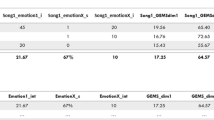Abstract
A survey of emotion in North Indian classical music was undertaken to determine the type and consistency of emotional responses to raag. Participants listened to five one-minute raag excerpts and recorded their emotional responses after each. They were asked to describe the emotions each excerpt evoked and then to adjust six different sliders indicating the degree to which they felt the following: happy, sad, peaceful, tense, romantic, longing. A total of 280 responses were received. We find that both free-response and quantitative judgments of emotions are significantly different for each raag and quite consistent across listeners. We hypothesized that the primary predictors of emotion in these excerpts would be pitch-class distribution, pitch-class dyad entropy, overall sensory dissonance, and note density. Multiple regression analysis was used to determine the most important factors, their relative importance, and their total predictive value (R 2). The features in combination explained between 11% (peaceful) and 33% (happy) of response variance. For all models, a subset of the features were significant, with the interplay between “minor” and “major” scale degrees playing an important role. Although the explanatory power of the current models is limited, the results thus far strongly suggest that raags do consistently elicit specific emotions that are linked to musical properties. The responses did not differ significantly for enculturated and non-enculturated listeners, suggesting that musical rather than cultural factors are dominant.
Preview
Unable to display preview. Download preview PDF.
Similar content being viewed by others
References
Bhatkande, V.: Hindusthani Sangeet Paddhati. Sangeet Karyalaya (1934)
Balkwill, L.L., Thompson, W.F.: A cross-cultural investigation of the perception of emotion in music: Psychophysical and cultural cues. Music Perception 17, 43–64 (1999)
Juslin, P.N., Sloboda, J.A.: Music and Emotion: Theory and Research. Oxford University Press, Oxford (2001)
Chordia, P., Rae, A.: Raag recognition using pitch-class and pitch-class dyad distributions. In: Proceedings of International Conference on Music Information Retrieval (2007)
Huron, D.: Sweet Anticipation: Music and the Psychology of Expectation. MIT Press, Cambridge (2006)
Sun, X.: A pitch determination algorithm based on subharmonic-to-harmonic ratio. In: Proc. of International Conference of Speech and Language Processing (2000)
Duxbury, C., Bello, J.P., Davies, M., Sandler, M.: A combined phase and amplitude based approach to onset detection for audio segmentation. In: Proc. of the 4th European Workshop on Image Analysis for Multimedia Interactive Services (WIAMIS 2003), London, pp. 275–280 (2003)
Kameoka, A., Kuriyagawa, M.: Consonance theory, part i: Consonance of dyads. Journal of the Acoustical Society of America 45(6), 1451–1459 (1969)
Author information
Authors and Affiliations
Editor information
Rights and permissions
Copyright information
© 2008 Springer-Verlag Berlin Heidelberg
About this paper
Cite this paper
Chordia, P., Rae, A. (2008). Understanding Emotion in Raag: An Empirical Study of Listener Responses. In: Kronland-Martinet, R., Ystad, S., Jensen, K. (eds) Computer Music Modeling and Retrieval. Sense of Sounds. CMMR 2007. Lecture Notes in Computer Science, vol 4969. Springer, Berlin, Heidelberg. https://doi.org/10.1007/978-3-540-85035-9_7
Download citation
DOI: https://doi.org/10.1007/978-3-540-85035-9_7
Publisher Name: Springer, Berlin, Heidelberg
Print ISBN: 978-3-540-85034-2
Online ISBN: 978-3-540-85035-9
eBook Packages: Computer ScienceComputer Science (R0)




